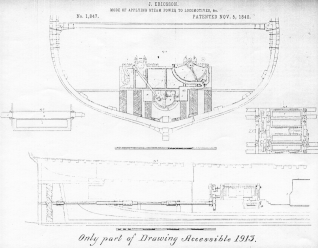

From the St. Louis Intelligencer, Jan. 7.
Our dispatches of yesterday morning informed us of a great event. The first Caloric Ship was loosed from her moorings at New York, on the 4th day of January, 1853, and driven over the bosom of the waters by an agent hitherto unknown, except in some very dissimilar capacity. The experiment is worth anything to sustain prediction, the reign of steam must date its decline, if not its downfall, from that day.
It was not anticipated by Mr. Ericsson or his friends that the new motive power would rival steam in more rapidity of propulsion -- at least until after many points of improvement should have been suggested by experiment. It was enough for him and the most sanguine of his supporters, that it should compete with the average rate of sailing vessels upon long voyages. Skeptics required still less. If caloric could reach the point of speed which steam had attained twenty years ago, they were willing to admit that its extraordinary advantages in other particulars would enable it to effect a quick and wonderful revolution in navigation. Skepticism is now silenced by a result far more satisfactory than it demanded. Fortune and fame are lying at the feet of the happy inventor.
The one great feature which will enable the Caloric engine to rapidly supercede other motive machinery, is the wonderful cheepness of its operation. To this also, may be added its absolute safety as regards life and property. The first mentioned quality has a double exemplification in its application to sea-going vessels. Not only will the cost of fuel be merely fractional compared with that upon steam vessels, but the additional room for freight, now occupied with huge supplies of coal, will command a greatly increased profit upon the voyage. It has been generally stated that the Caloric engine will consume but one-fifth the quantity of fuel required for a steam-engine of similar capacity. We have reason to believe that even this estimate does injustice to the former, and was probably meant to leave a wide margin for the errors of enthusiastic anticipation. Practical business men declare that a steamship which now requires two thousand tons of coal for a voyage across the Atlantic, make the trip with a caloric engine upon ninety. A gentleman well known to the citizens of St. Louis, informs us that he not long since supplied a steamship with coal for the trip from Panama to San Francisco and back, at an expense of fifty thousand dollars. Had she used the Ericsson engine, her saving would have been, by the first estimate forty thousand, and by the second estimate over forty-seven thousand dollars! Does it look extravagant to say that a revolution is dawning in ocean navigation?
A scientific Englishman said, a few years ago, that if steamships ever crossed the Atlantic, he would "eat the boiler of the first boat." The impracticability mistakenly imagined by him, has been almost fully realized in another line of steamship travel -- that of rounding the great capes of two hemispheres. No steam vessel can carry one-fourth of the coal requisite for a voyage from New York to San Francisco, or one from Liverpool to Calcutta. The inconvenience and loss of time in putting into intermediate ports, together with the uncertainty of obtaining supplies of fuel and the great cost of them, when obtained, have utterly excluded the steam marine of both continents from any sort of competition with sailing vessels. A few have been made around both capes; but they only established the utter incapacity of steam as an agent in the operations of commerce by way of those vastly important routes. In this field, principally, will the greatest triumphs of the caloric engine be achieved.
To illustrate the estimation in which Ericsson's undertaking was held but a short while since, we may mention an incident that occurred while the caloric ship was yet in the docks, and after her wheels had been put in motion. The citizen of St. Louis, to whom we have already referred, together with Mr. Howland, of the well known firm of Howland & Aspinwall, spent a night on board of her, intending to satisfy themselves as to the uninterrupted working of the machinery. Before they went on board, according to our informant, they would not have risked a picayune upon the availability of the invention. On the following morning they would have been willing, without waiting for an experimental trip, to insure at a reasonable per centage its unqualified and thorough success. Within a day or two of the same circumstances, Mr. Ericsson received an offer of one million dollars for the use of his patent right upon the Pacific Ocean.
After all, the crowning glory of this invention, if nothing should vitiate its present assurances of success, will be the safety guaranteed by it to human life. No more disastrous explosions; little or no danger, comparatively, from fire; none of the leakage hitherto occasioned by placing the bed-plate bolts through the bottom of the vessel. The perils of sailing navigation, too, will be measurably obviated; for nothing has been wanting, hitherto, to annihilate the terrors of a lee shore, save only a sufficient motive power within the ship.
Altogether, it seems not unreasonable to look for as rapid a general introduction of the caloric engine, as we witnessed but a few years ago of the magnetic telegraph.

A native of Sweden, John Ericsson (1803 - 1889) was an engineering genius who involved himself in the development or improvement of power transmission. He invented the ship propeller and later designed and built the Monitor for the Union Navy in the War of the Rebellion.


© Copyright 2008 SFgenealogy. All rights reserved.